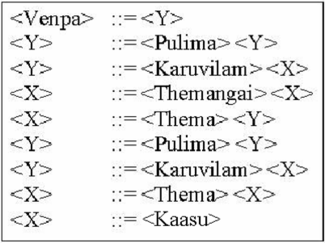Venpa
Venba (வெண்பா in Tamil) is a form of classical Tamil poetry. Classical Tamil poetry has been classified based upon the rules of metric prosody. Such rules form a context-free grammar. Every venba consists of between two and twelve lines.
Popular books written in venba style
- All 1330 couplets from Tirukkural, composed by Tiruvalluvar are examples of venba. Tirukkural comes under a sub-category of venba called Kural venba, wherein each Kural has only two lines.
- Nala venba1 is another classical work written in venba style.
- Niti venba2 is another venba style book that preaches values.
Basic elements of meter in classical Tamil poetry
Vowels and consonant-vowel compounds in Tamil alphabet have been classified into ones with short sounds (kuril) and the ones with long sounds (nedil). A sequence of one or more of these units optionally followed by a consonant can form a ner asai (the Tamil word asai roughly corresponds to syllable) or a nirai asai depending on the duration of pronunciation. Ner and Nirai are the basic units of meter in Tamil prosody. A siir or cheer is a type of metrical foot that roughly corresponds to an iamb. Thalai is the juxtaposition of iambic patterns.
Note that the official terms for the different "asai"s are self-descriptive. For example, the word "ner" is itself classified as ner asai. And the word "nirai" is a nirai asai.
Grammar for meter in Venba
A set of well defined metric rules define the grammar for venba. Such rules have been proved to form a context-free grammar.[1]
One set of rules constrains the duration of sound for each word or cheer, while another set of rules defines the rules for the possible sounds at the beginning of a word that follows a given sound at the end of the preceding word. Any venba should conform to both these sets of rules.
Following is the set of production rules corresponding to the first set of rules.
<VENBAA> → <ADI>{1-11} <EETRADI>
<ADI> → <CHEER> <CHEER> <CHEER> <CHEER>
<EETRADI> → <CHEER> <CHEER> <EETRU CHEER>
<CHEER> → <EERASAI> | <MOOVASAI>
<EETRU CHEER> → <NAAL> | <MALAR> | <KAASU> | <PIRAPPU>
<EERASAI> → <THEMAA> | <PULIMAA> | <KARUVILAM> | <KOOVILAM>
<MOOVASAI> → <THEMAANGAAI> | <PULIMAANGAAI> | <KOOVILANGAAI> | <KARUVILANGAAI>
<THEMAA> → <NER> <NER>
<PULIMAA> → <NIRAI> <NER>
<KARUVILAM> → <NIRAI> <NIRAI>
<KOOVILAM> → <NER> <NIRAI>
<THEMAANGAAI> → <THEMAA> <NER>
<PULIMAANGAAI> → <PULIMAA> <NER>
<KARUVILANGAAI> → <KARUVILAM> <NER>
<KOOVILANGAAI> → <KOOVILAM> <NER>
<NAAL> → <NER>
<MALAR> → <NIRAI>
<KAASU> → <NER> <NER>
<PIRAPPU> → <NIRAI> <NER>
<NER> → <KURIL> | <NEDIL> | <NER> <OTRU>
<NIRAI> → <KURIL> <KURIL> | <KURIL> <NEDIL> | <NIRAI> <OTRU>
<KURIL> → {VOWELS OR COMPOUNDS WITH A SHORT SOUND}
<NEDIL> → {VOWELS OR COMPOUNDS WITH A LONG SOUND}
<OTRU> → {CONSONANTS, WHICH HAVE AN EXTREMELY SHORT SOUND}
1. {1-11} is not a standard BNF notation but a widely accepted EBNF notation indicating
repetition of number of times specified in the range.
2. The grammar has some redundant productions that have been retained so as to preserve
the semantics as described originally in Tamil grammar.
Following is the set of production rules corresponding to the second set of rules.
<VENBAA> → <X> | <Y>
<X> → <THEMAA> <Y>
<X> → <KOOVILAM> <X>
<Y> → <PULIMAA> <Y>
<Y> → <KARUVILAM> <X>
<X> → <NAAL> | <KAASU>
<Y> → <MALAR> | <PIRAPPU>
[If the above rules are conformed to, the thalai is said to be Iyarcheer vendalai]
<X> → <THEMAANGAAI> <X>
<X> → <KOOVILAANGAAI> <X>
<Y> → <PULIMAANGAAI> <X>
<Y> → <KARUVILANGAAI> <X>
[If the above rules are conformed to, the thalai is said to be Vencheer vendalai]
Example
Following is a couplet from Tirukkural:
உடுக்கை இழந்தவன் கைபோல ஆங்கே இடுக்கண் களைவதாம் நட்பு. (a translation by G U Pope) "As hand of him whose vesture slips away, Friendship at once the coming grief will stay. (True) friendship hastens to the rescue of the afflicted (as readily) as the hand of one whose garment is loosened (before an assembly)."
 Parse tree for the above Kural for the first set of grammar rules given in the grammar section - Note: 0 represents 'kuril' and 1 represents 'nedil' |  Set of productions for the same Kural for the second set of rules given in the grammar section |
References
- ↑ L, BalaSundaraRaman; Ishwar. S; Sanjeeth Kumar Ravindranath (2003-08-22). "Context Free Grammar for Natural Language Constructs - An implementation for Venba Class of Tamil Poetry". Proceedings of Tamil Internet, Chennai, 2003. International Forum for Information Technology in Internet. pp. 128–136. Retrieved 2006-08-24.
External links
- Nala Venba (pdf version)
- Niti Venba (TSCII encoding)
- வெண்பா புனைவோம் வருக (Let's write venba)
- யாப்புலகம்
- வெண்பா விதிகள்
- வெண்பாவின் ஈற்றடி
- Context Free Grammar for Natural Language Constructs. An implementation for venba Class of Tamil Poetry (2003, conference paper)